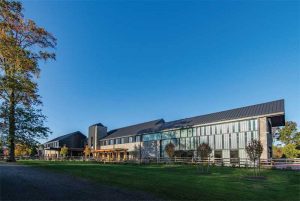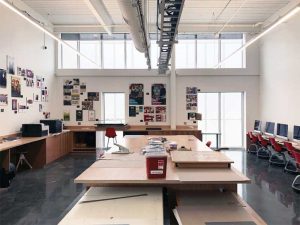Helping schools see the light: Data reveals daylighting’s importance in education
by brittney_cutler | November 4, 2021 8:00 am
 [1]
[1]Like most projects, architectural choices in education projects are incredibly complex. Many decisions including critical energy performance and efficiency choices are especially crucial. The biggest influencers are the community and site where the school is being built. Also important are budget and requirements for specialty spaces; gymnasiums and auditoriums are large masses that influence school design. For the best impact and service to the community, every decision—from large roofing components to small bathroom fixtures and paint colors—are carefully chosen.
While many of those choices are sophisticated and require extensive building expertise to make a cohesive design solution, the first decision is rather simple. As reflected in so much of the world, that selection revolves around the sun. To achieve optimal energy performance and efficiency, the first and foremost decision is the building complex placement on site. A school’s orientation in relation to the sun can determine school effectiveness for helping the main reason it is being built—for students. Daylight, and how it is balanced, manipulated, and utilized, is one of the primary design considerations facing school architects.
“Every site is different, and every site has different constraints,” says Laura Wernick of HMFH Architects. “But if we can get the majority of the classrooms facing north and south, that really is a first important step for getting good, balanced daylighting in the classroom.”
Daylight is one of the most important elements because significant amounts of data within the past two decades indicates that daylighting improves student performance[2]. Achieving the right balance is tricky. Like Goldilocks and the porridge, there can’t be too much or too little.
Architects have a range of choices to influence the building design envelope and fenestration to determine how much daylighting penetrates buildings. At Johnson County Community College in Kansas, BNIM Architects used fritted glass, combined with an etched glass on surface #4, to create a strong light diffusing effect. Another example is at Kean University in New Jersey, where NK Architects used double-glazed, low emissivity (low-e) coated channel glass walls with different textures, installed in thermally broken frames to integrate their design aesthetic.
As technology advances and supports designers’ choices, so do the technical options for architects designing schools. Today, there are programs that help determine designs which achieve the optimal daylighting balance. Gone are the days of rectilinear schools being constructed with ceiling to floor unfiltered glass or light-defying structures heavy on brick and mortar. These schools are now just as rare as the one-room schoolhouse because of this understanding of how light affects the education process.
Abundantly Clear Data
Daylighting and its impact on student performance has been evident for more than two decades. The most influential report came from a study by the Heschong Mahone Group for Pacific Gas & Electric Company in 1999. The conclusion in this report from 21,000 students tested in three states found students in classrooms with the most daylighting progressed 20 percent faster on math tests and 26 percent faster on reading tests in one year than those with less amount of daylighting.
Since that groundbreaking study, subsequent tests have found similar conclusions aligning with these choices. One of the most recent studies came in 2020[3], by Sinphonie Consortium, which found European students in classrooms with proper daylighting performed better in math and logic tests.
“Overall, our findings suggest classroom characteristics associated with daylighting do significantly impact the performance of the school children and may account for more than 20 percent of the variation between performance test scores,” the report concludes.
Natural light[4] does more than boost student performance; it can also impact health. Studies show natural light can boost the body’s vitamin D storage, improve mood, reduce depression, improve sleep and circadian regulation, and relieve Season Affective Disorder (SAD). The Center for Educational Improvement (CEI) wrote: while “there is no consensus” on the cause of SAD, “there is indirect evidence that supports the idea that reduced sunlight exposure is a major factor.”
Daylighting can also impact the building’s lighting, heating, and cooling costs for the lifecycle of operation. U.S. school systems spend approximately $8 billion each year on energy. According to the U.S. Energy Information Administration, about 26 percent of electricity consumed by a typical school is for lighting[5].
With so much riding on the outcome—educationally, financially, and physically—architects should weigh every daylighting choice with precision and technology when available.
“The research seems abundantly clear,’’ says Andrew Lewis of NK Architects. “It’s important to understand the passage of time, and how light moves throughout the course of a day. Education in a school where the quality of light changes throughout the day is not the greatest place to learn. Having views to the outdoors is also important. Even in healthcare work, the research is even more clear. People who are in a hospital room recover faster when they have a view and can see nature.”
 [6]
[6]Perfect Balance: Design
Site placement, and building design working with daylight, are the primary objectives for architects to achieve the proper balance.
“Our goal is to get uniform light deep into academic spaces so there are not any bright spots, dark spots, or glare,” says Wernick. “We try to design for uniform light within the learning space.”
Site orientation is the first step toward achieving that balance. Sites vary with elevation changes and it is not always easy to accommodate a plan for a north-south structure.
“There might be a slope, wetlands constraints, or vehicular constraints that might make the building layout more compatible if you are going east-west,” says Wernick. “We are always trying to make sure we’re designing the school in context with the site. We also don’t want to cause huge disturbances on the site. We try to get as close to north-south orientation with as many of the classrooms as we possibly can.”
Providing proper daylight balance is also determined by other factors such as space use. A gymnasium or a swimming pool, for instance, will have fewer windows to reduce glare that may disrupt competition. Science labs might have different lighting needs than the student library.
The project at Kean University by NK Architects was especially complex. The Liberty Hall Academic Center includes spaces for research, teaching, archiving, preservation, gallery display, and a flexible exhibit hall. Some exhibits include fabrics from the colonial era, which could be harmed by sunlight.
“We do have natural light, but we used a product that was a fairly opaque glass. It was very filtered, but it’s still natural light,” says Lewis.
NK Architects selected light-diffusing textured channel glass with a low-e coating, interspersed with clear glass channels used as vision lites. The thermally coated channel glass achieves U-value of 0.41, while maintaining daylighting advantages with approximately 64 percent visible light transmittance (VLT). Unique to this three-dimensional glass material, the low-e coating also creates a subtle iridescent appearance.
Architects always need to balance daylighting with thermal performance. The intersection of light and thermal efficiency, especially in extreme climates, is a difficult tightrope to navigate.
“Daylighting and thermal comfort are very, very closely interwoven,” says Wernick. “We have design strategies to get natural light into the classroom, but we also have to think about thermal control and comfort at the same time.”
That conundrum of design and facility needs lead to one other important aspect: the budget. Architects must consider the upfront cost of the project, as well as the impact of material selection on the thermal performance and energy costs after the building is completed. A more costly architectural choice during construction may dramatically reduce operational heating and cooling costs.
The tough decision for an owner (community) is to provide the dollars now to save money in operations throughout the lifetime of the facility, a hard decision to make for the future by the school system making this decision.
“Sometimes you give those things consideration as quickly as you can,” says Lewis. “It’s a lot easier when a client says they can’t afford it right at the beginning. There’s a lot of nuances involved and a million different things to balance the budget. You have to have those deep conversations.”
It is the designers’ task to help guide the client to a decision that meets both budget and lifecycle decisions of the development.
Architectural Choices
Fortunately for architects, the advancing of design support technology has led to a wide range of products that help designers to understand materials and items that control the amount of daylight that streams into buildings. Glass is one of the main engineered solutions.
“There is a tremendous amount of technology and an unbelievable amount of glass types,” says Lewis. “They all do different things. They let in a certain amount, or block out light, some look different, and some perform better from a thermal standpoint. There is a lot of science behind the glass these days, and that’s the first line of defense in planning decisions.”
Johnson County Community College offers an example of a project that meets multiple objectives. The college’s Fine Arts and Design Studio is enveloped in a customized ventilated glass façade that filters soft, glare-free daylight into the studios.
The 52-m (170-ft) wide façade includes fritted glass laminated to etched glass on surface #4 to create a strong, light-diffusing effect. Behind the translucent glass façade, traditional windows fill the studios with soft, glare-free, filtered daylight. The secondary glass façade is also designed so it can double as a projection screen for student art, eventually transforming into a lit canvas.
It also prevents moisture damage and shields the structure from rain and wind. On the interior, hallways are clad in magnetic glass marker boards with a special matte finish, specified to eliminate harsh reflections and glare.
The Kean University project took a different path. In this case, architects specified 162.5 m2 (1750 sf) of channel glass with 25 to 40 percent post-consumer recycled content in two different textures. The double-glazed channel glass walls effectively manage daylight, while also controlling water drainage and thermal transfer. The project won an award from the American School & University, which praised Liberty Hall’s “good use of texture and light to provide vitality” and its dynamic spaces and detailing.
Channel glass is a versatile specialty product for exterior and interior wall applications, which can be used in everything from façades to interior partitions. It provides soft, even light distribution. Channel glass can be specified in a range of bird-friendly textures, performance coatings and insulation options, delivering U-value ranges from 0.49 to 0.19, and VLT ranges from 72 to 37 percent.
Bird-safe glass is guided by a “2×4” rule, which presents an easy formula for an effective glass solution. Essentially, it stipulates horizontal design elements should be placed no more than 51 mm (2 in.) from each other, and vertical design elements should be spaced no more than 102 mm (4 in.) apart.
More and more communities are requiring bird friendly glass on new construction and major renovations. For instance, New York City adopted legislation requiring bird friendly glass on new construction in 2020. Further, the American Bird Conservancy is advocating a bill to enact nationwide bird friendly guidelines for federal buildings.
“There are some interesting textural opportunities with channel glass you don’t see as much in contemporary glazing systems,” says Lewis. “You can also get much larger expanses of glass. With a single sheet of channel glass, you can also get 23 ft (7 m) vertical coverage. This expanse of conventional glazing would be quite expensive, and it would need structural support. Channel glass can be clipped in, so it’s easier and faster to install.”
Wernick says windows are also an important architectural tool and can be used in a variety of ways.
“In an entryway, we might use a lot of windows to welcome people and to designate an important piece of the building,” she says. “Windows are a great tool for providing variety and differentiation across the building and are used to define the exterior form through solid-void relationships, as much as they are used to allow daylight to define interior forms.”
Wernick, who has been designing schools for almost 40 years, says she also incorporates light shelves into her projects that reflect light deeper into spaces and help reduce glare near the exterior wall.
“A light shelf can be a solid or translucent surface inside or outside the window located above the viewing portion of the opening,” says Wernick. “It is intended to simultaneously bounce daylight deeper into the space in conjunction with a high and reflective ceiling and reduce glare at the viewing portion of the window by shading it.”
The use of glass façades, scrims, windows, skylights, and other solutions that allow natural light must be balanced with thermal performance. Student performance, heat gain, and cooling loads, as well as community budgets are all important factors to consider.
Getting It Right
Besides the advanced engineered and manufactured product offerings, today’s architects also benefit from pre- and post-construction analysis reports. Technology from advancing energy modeling programs can offer architects insight. The use of these technologies helps to adjust material selections and fenestration opening sizes orientation, etc.
“With that kind of information, you can develop the appropriate technical and physical characteristics of the building,” says Lewis. “You begin to understand what the light conditions are, how to provide views for the student environment, and being able to deliver things that are important in an educational environment.”
After a project is complete, architects get the privilege to work with some clients to learn whether the preliminary modeling was accurate and becomes a learning or research tool.
“In the past, the tools and public awareness were not as evolved as they are today,” says Wernick. “Now we’re getting more aggressive about collecting energy performance data from our clients afterwards. We model the projects very carefully and have projections about how much energy was going to be used and how much daylighting can contribute. We are now looking to see how accurately modeling aligns with actual use, because we’re really trying to dial into the energy efficiency of buildings to make sure it’s as tight as possible. We need to know what worked and what didn’t work.”
Community Pride
Saugus Middle-High School in Massachusetts, designed by HMFH Architects, was awarded top prize for the ‘education design’ of the facility. The 25,177-m2 (271,000-sf), $161-million project serves 1360 students in grades six through 12, and incorporates exhibits that honor the town’s landmarks, industries, and people.
Daylight floods the school’s interior spaces through lightwells and skylights, and an on-site tri-generation plant produces electricity and captures generated heat to reuse for heating, cooling, and hot water. The tri-gen plant also provides emergency and backup power during a power outage on the electric grid. This, along with good daylighting, enhance the resiliency of the building for the community at large.
Daylighting, energy efficiency, and student achievement were all important aspects of the design of the Massachusetts school, just as they were at Kean University, and Johnson CCC. Similarly important is the sense of pride the community feels in new construction. Whether it is a New Jersey college, a Massachusetts public school, or a midwestern community college, a thoughtfully designed new building provides an undeniable emotional lift to the community.
A new building can improve property values, entice students, and attract community attention. Daylighting and its inherent advantages may not be obvious to the public, but an innovative exterior is visible to everyone. It can inspire civic pride and bind a community.
“Ultimately, it’s about making sure we have the best learning environment for the students and that the community is getting a building they’re proud of and can utilize,” says Wernick.
“These are very important buildings that hopefully will be a source of pride for the community. As we saw during COVID, schools are a place where people go to get food, get their technology distributed, and host community and civic events. Schools are helping the future by providing the best environment for educating kids and hopefully supporting communities,” says Wernick.
- [Image]: https://www.constructionspecifier.com/wp-content/uploads/2021/11/Bendheim-channel-glass-Kean-daytime.jpg
- performance: http://sunwestdistributors.com/wp-content/uploads/2013/05/education.pdf.
- 2020: http://www.mdpi.com/1660-4601/18/1/258/htm.
- Natural light: http://www.edimprovement.org/post/combating-seasonal-affective-disorder-in-schools.
- lighting: http://www.eia.gov/consumption/commercial.
- [Image]: https://www.constructionspecifier.com/wp-content/uploads/2021/11/JCCC-Bendheim-glass-facade-interior.jpg
Source URL: https://www.constructionspecifier.com/helping-schools-see-the-light-data-reveals-daylightings-importance-in-education/
 Thomas Renner writes on building, construction, engineering, and other trade industry topics. He is based in Stamford, Connecticut. He can be reached at trenner@catalystmc.com.
Thomas Renner writes on building, construction, engineering, and other trade industry topics. He is based in Stamford, Connecticut. He can be reached at trenner@catalystmc.com.